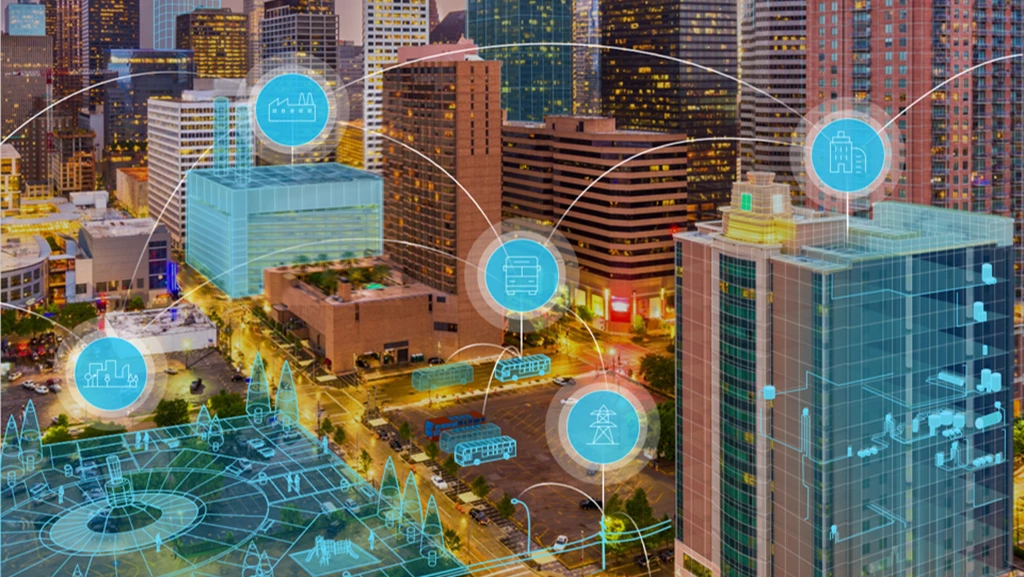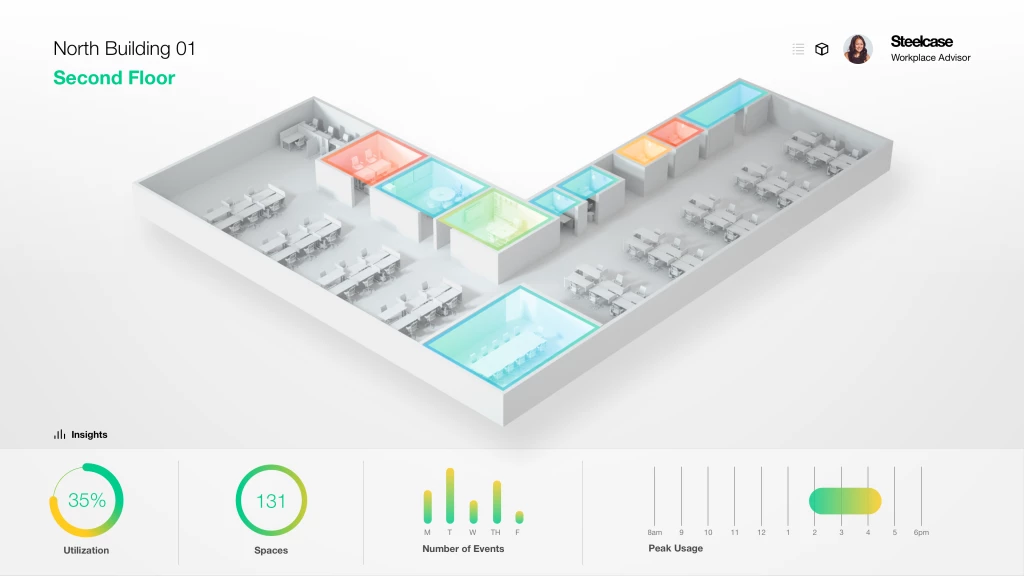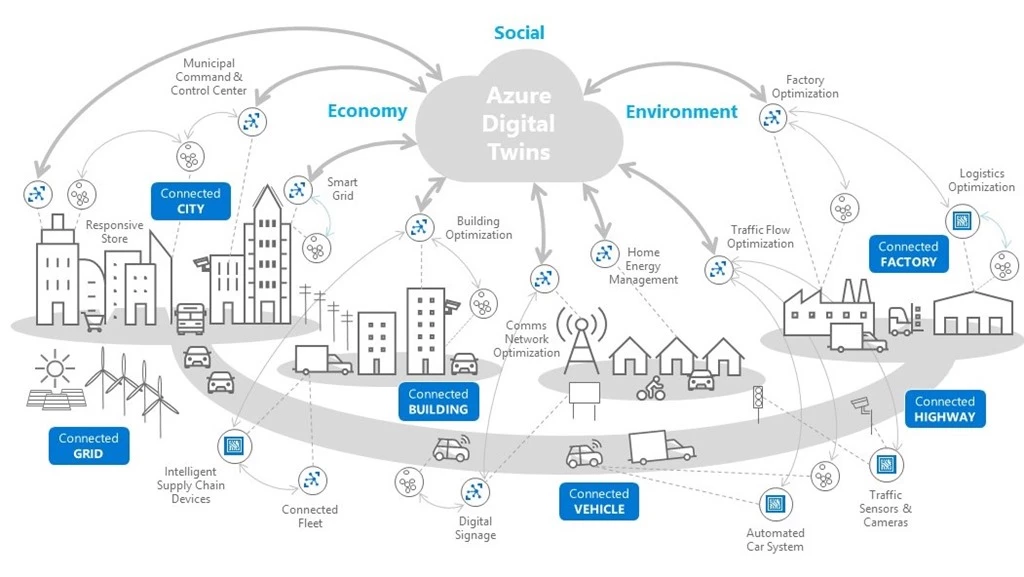Announcements, Digital Twins, Internet of Things
Announcing Azure Digital Twins: Create digital replicas of spaces and infrastructure using cloud, AI and IoT
Posted on
9 min read

For years now, our partners and customers have been using the Azure Internet of Things (IoT) platform to create breakthrough applications for a wide variety of industries. Along this journey, we’ve learned that most digital transformation efforts benefit from context about the physical world. As a result, organizations are showing a growing appetite for solutions that provide a deeper understanding of the sophisticated interactions between people, places, and things.
Enter the concept of the “digital twin”—a virtual representation of a physical environment that brings in data from a variety of sources. Historically, digital twins have been used for industrial equipment (machines, fleets of machines, engines, and the like), but the concept of a digital twin is also broadly applicable to modeling all the ways we live and work in our physical environment. Modeling the complex interactions and high-value intersections between people, places, and things is unlocking new opportunities, creating new efficiencies, and improving public and private spaces.
This is the context for a new service we’re adding to our IoT platform. Today at our Ignite conference in Orlando, we’re announcing the public preview of Azure Digital Twins. Azure Digital Twins is a new platform for comprehensive digital models and spatially aware solutions that can be applied to any physical environment. Partners and customers can now query data in the context of a space—rather than from disparate sensors—empowering them to build repeatable, scalable experiences that correlate data from digital sources and the physical world.
Azure Digital Twins has been developed as part of the Azure IoT platform to provide all of the scale, reliability, compliance, security, and privacy benefits Microsoft Azure is known for. It means environments of all types—offices, schools, hospitals, banks, stadiums, warehouses, factories, parking lots, streets, intersections, parks, plazas, and more—can become smarter spaces, and so can the supporting infrastructure and even entire cities.
About Azure Digital Twins
Most IoT projects today start from a things-centric approach, but we’ve flipped that around. We’ve found that customers realize huge benefits by first modeling the physical environment and then connecting (existing or new) devices to that model. Customers gain new spatial intelligence capabilities and new insights into how spaces and infrastructure are really used.
Privacy and security controls are an integral part of the Azure IoT platform. Once a digital model is in place, Azure Digital Twins uses Azure IoT Hub to connect the IoT devices and sensors that keep everything up-to-date with the physical world. Azure Digital Twins will help customers build next-generation IoT solutions that go beyond just connecting devices—predicting maintenance needs, analyzing energy requirements, optimizing the use of available space, creating more efficient processes, and more. Here’s a summary of the platform’s capabilities:
- Spatial intelligence graph. This is an actual virtual representation of a physical environment that models the relationships among people, places, and devices. This digital twin generates insights that allow organizations to build solutions that can improve energy efficiency, space utilization, occupant experience, and more. This includes blob storage—the ability to attach and store maps, documents, manuals, pictures, etc. as metadata to the spaces, people, and devices represented in the graph.
- Twin object models. The service also offers pre-defined schema and device protocols that align to a solution’s domain-specific needs to accelerate and simplify their creation. These benefits can apply to any interior or exterior space, as well as to infrastructure or even entire cities.
- Advanced compute capabilities. Users can define functions that generate notifications or events based on telemetry from devices and sensors. This capability can be applied in a variety of powerful ways. For example, in a conference room when a presentation is started in PowerPoint, the environment could automatically dim the lights and lower the blinds. After the meeting, when everyone has left, the lights are turned off and the air conditioning is lowered.
- Data isolation via multi- and nested-tenancy capabilities. Users can build solutions that scale and securely replicate across multiple tenants and sub-tenants by leveraging built-in multi- and nested-tenancy capabilities to ensure data is isolated.
- Security through access control and Azure Active Directory (AAD). Role-Based Access Control and Azure Active Directory serve as automated gatekeepers for people or devices, specifying what actions are allowed—and helping to ensure security, data privacy, and compliance.
- Integration with Microsoft services. Customers and partners can build out their solution by connecting Azure Digital Twins to the broader set of Azure analytics, AI, and storage services, as well as Azure Maps, Azure High-Performance Computing, Microsoft Mixed Reality, Dynamics 365, and Office 365.
Combined, these capabilities enable our partners to focus on driving results for their end customers by delivering advanced relational modeling while also addressing critical needs for privacy, security, and the ability to scale globally.
Digital Twins applications across industries
Azure Digital Twins is already being used by a broad set of customers and partners from a wide range of industries. Below are a few examples showing the applicability of Digital Twins to enhance operations just about anywhere.
Design, build, and operations
Digital Twins can be used across the life cycle of a building, leveraging data that was formerly lost or siloed between stages of design, construction, ownership, and occupancy. Willow, a global technology company headquartered in Australia, is addressing this need by creating a new category of innovation for the built environment.
Willow Twin provides a digital replica of the physical world that is simple and intuitive. The solution uses Azure Digital Twins’s cloud, AI, and IoT capabilities to model a building, track real-time data, and connect devices. Azure Digital Twins enables Willow to store the hierarchy and building data while feeding in details from other systems—architectural designs, warranties, manuals—providing one place to view all aspects of a building. Drawing on all of this historical and live data, Willow Twin creates actionable insights that can transform the operation of buildings and infrastructure and how people experience those assets.

Willow Twin provides a single place to view data relevant to design, construction, ownership, and occupancy. In this example, thyssenkrupp Elevator’s Test Tower is modeled, allowing operators to drill down into any element of the building and access a digital representation, as well as specifications, operating history, maintenance records, and manuals.
In partnership in Rottweil, Willow and Microsoft are helping thyssenkrupp Elevator unlock the vast data created in the central nervous system of their new Test Tower. The objective is to create new ways to manage maintenance contracts and security, develop personalized experiences for tourists, and ensure elevators are always functioning.
If the Test Tower has a service issue, like a water pump that stops operating properly, service technicians can use an app to view a 3D model of the building. They can roam around the model, enlarging or rotating as needed to locate a digital representation of the pump, and then access the unit’s specifications, operating history, maintenance records, and service manual to identify the issue and speed up repairs.
Willow plans to take Azure Digital Twins to customers in many sectors—commercial and office buildings, industrial spaces, multifamily developments, rail and infrastructure, airports, hotels, data centers, and more.
Building energy management
The smart buildings industry focuses on enhancing operations and energy savings. Solutions provider ICONICS was the first building energy partner to adopt the Azure Digital Twins platform, taking advantage of the platform’s pre-defined data schemas and advanced computing capabilities. ICONICS pulls telemetry from equipment and facilities, uncovering insights that can help reduce operating costs and improve tenant satisfaction.
With Azure Digital Twins, partners also have the benefit of connecting into other Microsoft offerings and the partner ecosystem. For example, MacDonald-Miller, a Seattle-based facility solutions company, uses Azure IoT services, Dynamics 365 for Field Service, and ICONICS Smart Building Software to dispatch service techs. They arrive with the right information, tools, and parts needed to make a first-time fix if a building’s system is using too much energy.
Space utilization and workplace design
Opportunities for building efficiency extend beyond energy savings, and space optimization is another big focus for organizations worldwide. Steelcase, a company with a 106-year history of designing for workspaces, is providing solutions that get more out of spaces.
Steelcase has used Azure Digital Twins to build the Steelcase Workplace Advisor and the Find Mobile App. Steelcase Workplace Advisor helps organizations see how their space is being used and create workplaces that respond to the needs of the people in them. For example, Steelcase worked with a growing company that was pinched for space and found that the utilization rate across their workplace was just 35 percent. Using data and analytics to reconfigure the space, they were able to increase the utilization to 51 percent in a short period of time.

Steelcase Workplace Advisor helps organizations see how their space is being used. In this example, Steelcase Workplace Advisor shows occupancy rates and trends over time.
Occupant experiences
The Azure Digital Twins platform is also being used to create better experiences for building occupants. CBRE, the world’s largest commercial real estate services firm, built their CBRE 360 employee- and tenant-experience platform leveraging Azure Digital Twins for analysis, to see how the space it manages is used and optimize it to better serve people’s needs.
With sensors to measure temperature, motion, and other conditions, CBRE can help clients understand their spaces and provide great experiences to the people working there. The CBRE 360 mobile app allows users to navigate the workplace, set up meetings with colleagues, reserve workspaces, and access food and beverage, building, and concierge services.
Together with Rigado, a global provider of commercial IoT edge-as-a-service solutions, CBRE and Microsoft are rolling out these services at CBRE’s most advanced buildings.
Another partner working on occupant experiences is Winvision, the Dutch technology partner of BeSense. They use Azure Digital Twins with Office 365 for occupancy and room-booking scenarios in workplaces.
Building exterior
The horizon for digital-twin potential stretches far beyond smart buildings and offices. According to Harvard Business Review Analytic Services, forward-thinking executives that already have an enterprise-wide approach to smart spaces also see a chance to embrace new markets. A commanding majority—82 percent—of this group say this type of technology will spread readily beyond offices and residential facilities into manufacturing plants, hospitals, retail stores, sports stadiums, schools, and other types of organizations.
Azure Digital Twins can be used outside of these diverse spaces in many different applications as well, including parking, exterior lighting, and electric vehicle (EV) charging, to name a few.
Allego, a leading provider of charging solutions and EV cloud services, tapped Azure Digital Twins to help them build a seamless charging experience for cities, companies, and consumers across their European network of almost 9,500 charge points.
The solution needed to incorporate the complex user preferences and energy-grid constraints associated with EV charging into a dynamic model. The goal: come up with the best charging schedule for plugged-in electric vehicles. The Digital Twins platform enabled them to model and optimize charging scenarios, resulting in a solution that provides flexible, reliable, and predictable charging options to customers. The system can even help grid operators minimize or avoid costly infrastructure upgrades.
Infrastructure and beyond
Beyond EV charging, for example, Azure Digital Twins provides exciting potential use cases for utilities and infrastructure. Adger Energi, a Norwegian electric utility, is using Azure Digital Twins to identify ways to operate its electrical grid more efficiently through distributed energy resources, device controls, and predictive forecasting—thus avoiding costly and time-consuming energy upgrades. This innovation in using distributed energy resources has already garnered industry recognition, receiving the Innovative Star of Energy Efficiency Award: Power Generation and Supply.
The possibilities for Digital Twins also extend beyond buildings and into models of campuses and cities. L&T Technology Services (LTTS) built a comprehensive solution for Smart Campus and Smart City applications. The solution provides a virtual representation of an entire connected campus and its building infrastructure, providing AI-led facility fault detection, diagnosis, and reporting, as well as real-time feedback and resolution loops for facility managers, campus security, and mission-critical facilities.
LTTS i-BEMS integrates Azure Digital Twins and Dynamics 365 for Field Service to provide real-time automated IoT alerts, ticketing, and resolution management with minimal human intervention, accelerating the time to resolution. LTTS i-BEMS Digital Twin dashboards optimize building energy management, space utilization, workplace configuration, and tenant experience management.

With Azure Digital Twins, environments of all types (offices, schools, hospitals, banks, stadiums, warehouses, factories, parking lots, streets, parks, etc.) can all become smarter, along with the electrical grids that connect them and the cities around them.
Digital models of the physical world: only the beginning
Earlier this spring, we announced that Microsoft is investing $5 billion in IoT over the next four years. Our goal is to simplify the journey in IoT so any customer, no matter where they’re starting from, can create trusted, connected solutions for digital transformation.
Azure Digital Twins offers a powerful example of how Microsoft continues to deliver on this commitment. By removing layers of complexity and accelerating the creation of innovative spatial intelligence solutions, Azure Digital Twins provides organizations with the foundation they need to create the next wave of innovation in IoT. And that means a more intelligent and connected world that empowers people and organizations to achieve more.
Azure Digital Twins will be publicly available for customers to begin building solutions October 15th. To learn more, visit our product page.
Further reading
- Azure Digital Twins Product Page
- thyssenkrupp lays the foundation for intelligent buildings with digital twin technology
- Rigado delivers IoT edge-as-a-service for smart workplace solution
- ICONICS makes smart buildings even smarter with Azure Digital Twins
- PCL Construction uses IoT with Azure to revolutionize the construction industry
- Steelcase Demonstrates the Smart and Connected Workplace with New IoT-Powered Solutions
- Allego offers electric vehicle smart charging solutions powered by Azure Digital Twins
- Innovative Star of Energy Efficiency Award: Power Generation and Supply
Learn more about Azure IoT.